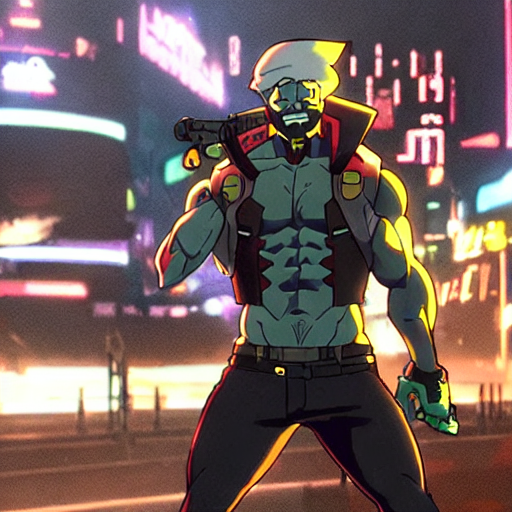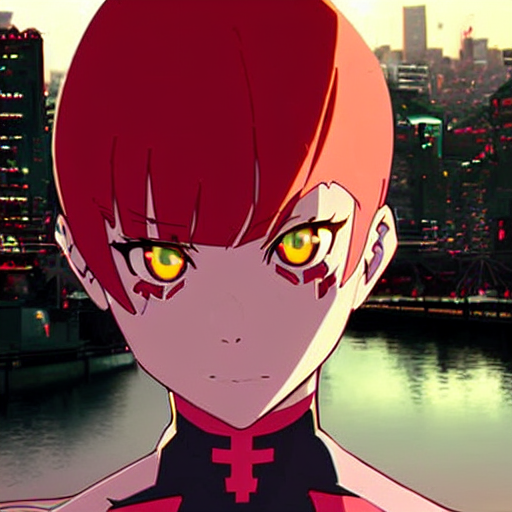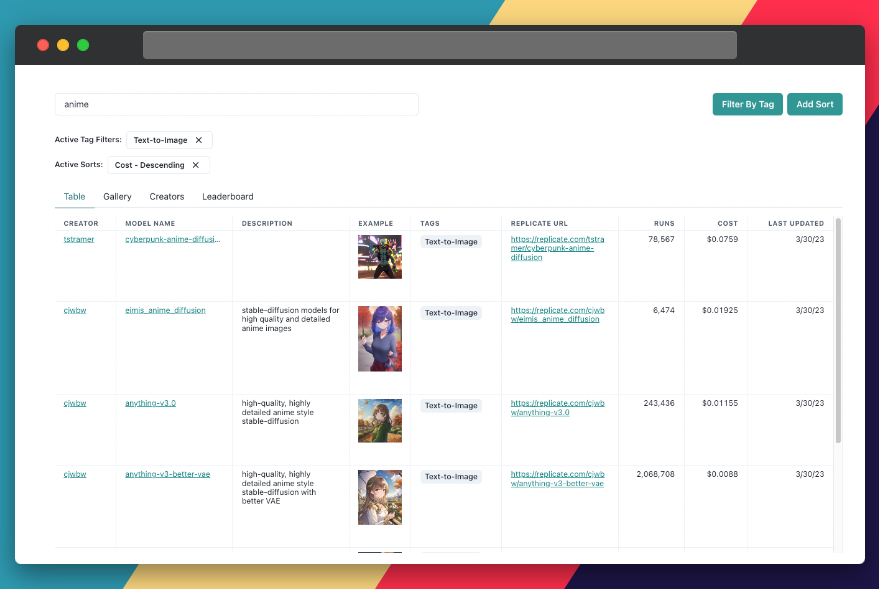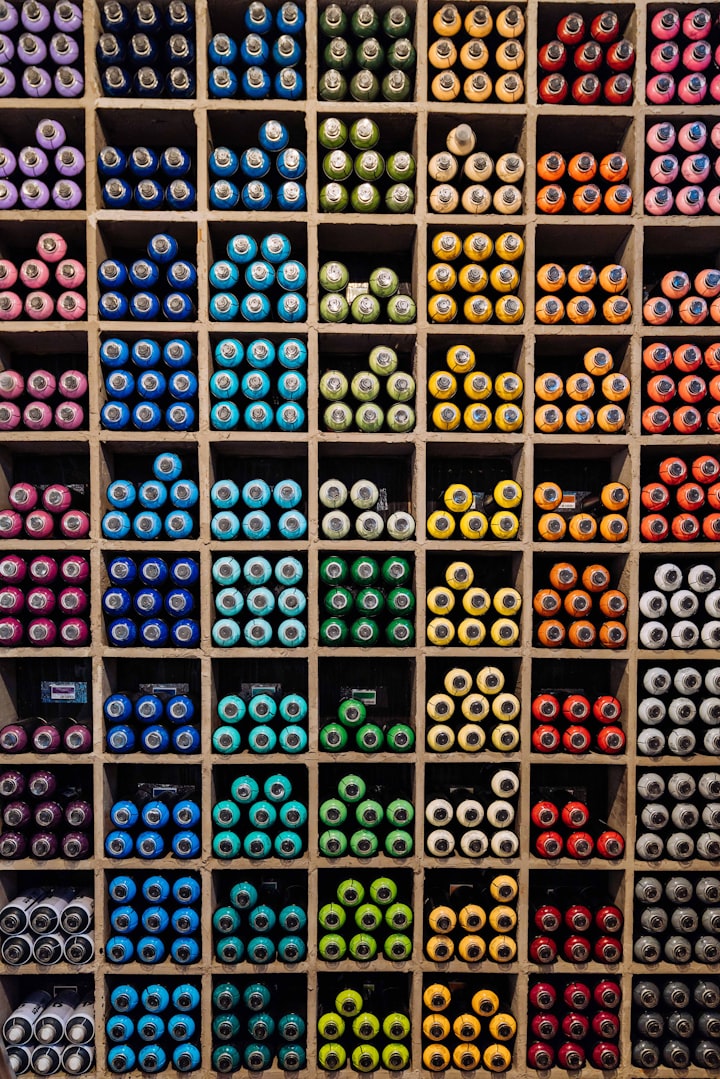Mastering the Cyberpunk-Anime-Diffusion Model
A comprehensive guide to the cyberpunk-anime-diffusion model on Replicate.

The cyberpunk-anime-diffusion model offers a fascinating way to create captivating and imaginative visuals. This guide will walk you through the basics of this model, ranked 56 on Replicate Codex, and show you how to harness its power for your own creations.
We'll learn how to use Replicate to run the model with a few simple lines of node.js code. We'll also explore how to use Replicate Codex to find similar models and decide which one best suits your needs. Let's dive in!
About the Cyberpunk-Anime-Diffusion Model
Created by tstramer, the cyberpunk-anime-diffusion model is a versatile AI tool that generates stunning images based on text prompts. The model focuses on transforming text into anime-style visuals with a cyberpunk twist. With 78,433 runs under its belt, the model is fairly popular, ranking 56 in popularity and its creator 11th in the rankings.

The model costs $0.0759 per run on average, using a Nvidia A100 GPU for prediction on Replicate. The average completion time for a single run is 33 seconds, making it reasonably fast and accessible for various creative projects.
What can you build with this model?
The Cyberpunk-Anime-Diffusion model offers a vast array of possibilities for creative applications and projects. Here are some potential use cases and the types of apps that could be built using this model:
- Customized Digital Artwork Generator: An app that allows users to generate unique, personalized digital artwork in the cyberpunk-anime style based on their input text. Users could create custom wallpapers, posters, or prints featuring their favorite characters, scenarios, or themes.
- Story Illustration: Writers or storytellers could use this model to create visuals for their stories, novels, or scripts. An app could be developed that integrates the model to generate illustrations based on specific scenes or descriptions, helping to bring the story to life and enhancing reader engagement.
- Concept Art Creation: Game developers, filmmakers, and other creative professionals could use this model to quickly generate concept art for their projects. An app could facilitate the generation of character designs, environments, or objects based on input descriptions, streamlining the creative process and saving time.
- Avatar and Profile Picture Generator: An app could be developed that allows users to create personalized cyberpunk-anime avatars or profile pictures based on their input text or descriptions. This could cater to a wide audience, including social media users, gamers, and online community members.
- Meme Generator: For a more light-hearted application, an app could be built to generate cyberpunk-anime styled memes based on user-provided captions or ideas, offering a unique twist on meme culture and sharing.
Basically, the sky is the limit!
Understanding the Inputs and Outputs of the Cyberpunk-Anime-Diffusion Model
Let's take a moment to understand the model's inputs before we try it out.
Inputs
The model takes several inputs to generate images:
- prompt: A text string that describes the desired image (e.g., "a photo of an astronaut riding a horse on Mars").
- negative_prompt: A text string specifying elements to avoid in the output.
- width and height: The dimensions of the output image (on Replicate, maximum size: 1024x768 or 768x1024 due to memory limits).
- prompt_strength: A value that determines the degree to which the initial image is destroyed (default: 0.8).
- num_outputs: The number of images to generate (default: 1).
- num_inference_steps: The number of denoising steps (default: 50).
- guidance_scale: A value that controls the scale for classifier-free guidance (default: 7.5).
- scheduler: A parameter that selects the scheduler type (default: DPMSolverMultistep).
- seed: A random seed value. Leave blank for randomized results.
Outputs
The model outputs an array of image URIs, which can be viewed or downloaded for further use. This comes as a simple JSON object, structured as shown below:
{
"type": "array",
"items": {
"type": "string",
"format": "uri"
},
"title": "Output"
}Now that we understand the inputs and outputs, let's explore how to use the model for our creative projects.
A Step-by-Step Guide to Using the Cyberpunk-Anime-Diffusion Model
Step 1: Create a Replicate Account
Before you start, you'll need a Replicate account. Sign up and make a note of your API key, as you'll need it for the following steps.
Step 2: Install the Replicate Node.js Client
Install the Replicate Node.js client by running:
npm install replicateStep 3: Set Up Your API Token
Set up your API token by running:
export REPLICATE_API_TOKEN=[token] And be sure to replace [token] with your actual API key.
Step 4: Run the Model
Use the following node.js code snippet to run the Cyberpunk-Anime-Diffusion model, customizing the input parameters as needed:
import Replicate from "replicate";
const replicate = new Replicate({
auth: process.env.REPLICATE_API_TOKEN,
});
const output = await replicate.run(
"tstramer/cyberpunk-anime-diffusion:c748e4408604eb0af43136d4a8bba9fa2c4c0bbae5180fce603d14e65f5a998e",
{
input: {
prompt: "a photo of an astronaut riding a horse on mars"
}
}
);
Refer to the inputs section above to add additional input parameters like size, a negative prompt, or a prompt strength value to your generation. For example, the following input values...
- Prompt: "a beautiful perfect face girl in dgs illustration style, Anime fine details portrait of school girl in front of modern tokyo city landscape on the background deep bokeh, anime masterpiece, 8k, sharp high quality anime"
- Negative prompt: ""
- Width: 512
- Height: 512
- Prompt Strength: 0.8
- Num Outputs: 1
- Num Inference Steps: 50
- Guidance Scale: 7.5
- Scheduler: DDIM
- Seed: 1
Gives the following output image:

Taking it Further: Finding Other Text-to-Image Models with Replicate Codex
Replicate Codex is an excellent resource for discovering AI models that cater to various creative needs, including image generation, image-to-image conversion, and more. It's a searchable, filterable, and tagged database of all the models on Replicate, allowing you to compare models, sort by price, and explore by creator. It's free and includes a digest email that alerts you when new models are released.
If you're interested in finding similar models to Cyberpunk-Anime-Diffusion, follow these steps:
Step 1: Visit Replicate Codex
Head over to Replicate Codex to begin your search for similar models.
Step 2: Use the Search Bar
Use the search bar at the top of the page to search for models with specific keywords, such as "text-to-image" or "anime." This will show you a list of models related to your search query.
Step 3: Filter the Results
On the left side of the search results page, you'll find several filters to help you narrow down the list of models. You can filter and sort models by type (Image-to-Image, Text-to-Image, etc.), cost, popularity, or specific creators.

By applying these filters, you can find the models that best suit your specific needs and preferences. For example, if you're looking for a text-to-image model that's the most popular or affordable, you can search and then sort by the relevant metric.
Conclusion
In this guide, we explored the Cyberpunk-Anime-Diffusion model and how to use it to generate captivating and imaginative visuals. We also discussed leveraging the search and filter features in Replicate Codex to find similar models and compare their outputs, allowing you to broaden your horizons in the world of AI-powered image generation.
I hope this guide has inspired you to explore the creative possibilities of AI and bring your imagination to life. Don't forget to subscribe for more tutorials, updates on new and improved AI models, and a wealth of inspiration for your next creative project. Thanks for reading, and have fun!
Subscribe or follow me on Twitter for more content like this!




Comments ()